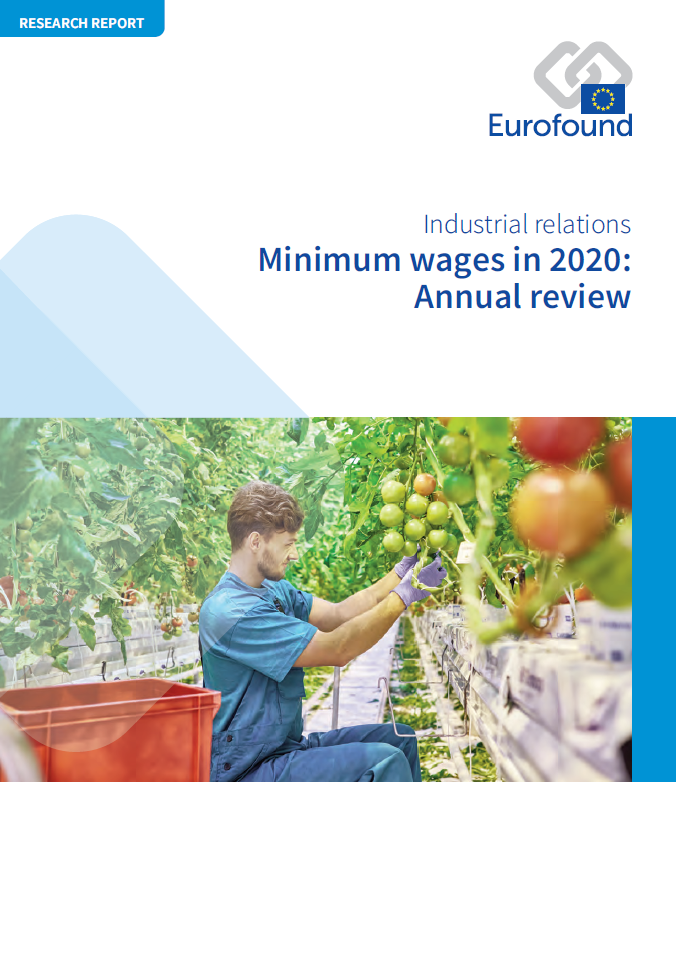
Ez a jelentés a minimálbérekről szóló éves sorozat részeként a tisztességes bérekre vonatkozó uniós kezdeményezés kapcsán, 2019 folyamán és 2020 elején történt fontosabb fejleményeket foglalja össze, egyúttal elhelyezi ebben a kontextusban a 2020-ra és azon túlra vonatkozó ráták meghatározására irányuló országos vitákat. A jelentés a minimálbérek megállapításának módját és a szociális partnerek szerepét mutatja be. Tárgyalja a törvényben előírt minimálbérek alakulását, azokból az országokból pedig, ahol nincs törvényben előírt minimálbér, a kollektív szerződésekben rögzített minimálbérekről közöl adatokat 10 alacsony fizetésű munkakörre vonatkozóan. A jelentésben külön rész foglalkozik a minimálbérek regionális dimenziójával, emellett bemutatja a minimálbér változásainak a bérekre, a foglalkoztatásra, a dolgozói szegénységre, az árakra és a nyereségre gyakorolt hatásairól szóló legfrissebb kutatásokat is.
Key findings
2019-ben sok országban tárgyalták a minimálbérek további, jelentős mértékű emelését 2020 után, részben egy relatív célhoz viszonyítva, részben pedig abszolút értelemben.
Az évezred kezdete óta a törvényben előírt minimálbérek más munkavállalók béréhez képest igazságosabbak lettek (ha a törvényben előírt minimálbért az összes munkavállaló bérének mediánjához hasonlítjuk).
Az emelkedő tendencia ellenére a minimálbér az országok többségében nem éri el a bérek mediánjának 60%-át, sőt, helyenként az 50%-át sem. Ez különösen igaz a közép- és kelet-európai tagállamokra, amelyek az évezred elején nagyon alacsony relatív szintről indultak, és a minimálbérre vonatkozó rendeleteikben továbbra is az 50% körüli vagy az alatti céloknál tartanak.
Összességében 10 minimálbéres munkavállaló közül 7 jelezte, hogy a megélhetéssel legalább valamilyen szinten nehézségei vannak, míg a többi munkavállaló esetében ez kevesebb, mint 10-ből 5; ezek a számok azonban országonként nagy változatosságot mutatnak. Dániában, Finnországban, Németországban és Svédországban például a minimálbérért dolgozó munkavállalók kevesebb mint 10%-a találja nehéznek vagy nagyon nehéznek a megélhetést; ezzel szemben Bulgáriában, Horvátországban és Cipruson 50–60% közötti ez az arány, Görögországban pedig eléri a 80%-ot.
A kormányok szerte Európában jövedelemstabilizációs intézkedéseket hoztak azok számára, akiket érintett a Covid19-válság. A minimálbérnek ebben a politikamixben az lehet a szerepe, hogy stabilizálja a jövedelmeket és ezáltal a keresletet, hogy ellensúlyozza a recesszióba vagy depresszióba vezető negatív spirált.
Data
Find data on statutory minimum wages in the EU.
- Data: Proportion of minimum wage workers who find it difficult to make ends meet, EU average
- Data: Minimum wage developments in real terms, 15 euro area countries, 2015 price levels
- Data: Proportion of minimum wage workers who find it difficult to make ends meet
- Data: Statutory minimum wages - Minimum wages in the EU in 2020
List of tables
- Table 1: Social partners’ first reactions to the announced initiative on fair wages
- Table 2: Overview of main arguments and proposals concerning an EU minimum wage initiative from social partners
- Table 3: Gross minimum wages, selected EU Member States and the UK, 2019 and 2020
- Table 4: Sub-minimum rates for selected EU Member States and the UK as at 1 January 2020
- Table 5: Further statutory minimum wage rates for private sector workers in selected EU Member States
- Table 6: Number of collective agreements covering low-paying job categories for countries without statutory minimum wages
- Table 7: Minimum wages in collective agreements, applicable in 2019 for selected low-paid jobs
- Table 8: Collective agreement coverage in Finland
- Table 9: Overview of debates during 2019 on aspects of the minimum wage setting processes
- Table 10: Demands for and agreements on targets for future minimum wages to address adequacy in selected EU Member States and the UK
- Table 11: Regional statutory minimum wage rates
- Table 12: Latest minimum wage research in EU Member States and the UK
- Table 13: Overview of recent empirical research in the EU, Norway and the UK on employment impacts of minimum wage increases, 2019
- Table 14: Policies influencing in-work poverty
- Table A1: Network of Eurofound Correspondents – Members participating in the research
List of figures
- Figure 1: Conceptualising adequate minimum wages
- Figure 2: Estimated share of employees earning 90% to 110% of the minimum wage, EU Member States, 2017
- Figure 3: Proportions of female and male employees, EU level, 2017
- Figure 4: Proportion of minimum wage workers per sector, EU level, 2017
- Figure 5: Proportion of minimum wage workers per occupation (top 10), EU level, 2017
- Figure 6: Hourly minimum wages, selected EU Member States, 2020
- Figure 7: Minimum wage developments in real terms, 15 euro area countries, 2015 price levels
- Figure 8: Minimum wage developments in real terms, non-euro area, 2015 price levels
- Figure 9: Impact of purchasing power on the minimum wage value for selected EU Member States and the UK, as at 1 January 2020
- Figure 10: Relative distance between purchasing power of lowest and median minimum wage EU Member States and the UK and highest minimum wage EU Member States and the UK, 2010–2020
- Figure 11: Process for determining minimum wage rates for 2020
- Figure 12: Number of minimum wage rate updates, EU Member States with statutory minimum wages and the UK, since 2010
- Figure 13: Longer-term trend of development of statutory minimum wages relative to median wages of full-time employed workers, selected countries within the EU and the UK, 2000–2018
- Figure 14: Proportion of minimum wage workers who find it difficult to make ends meet, EU average
- Figure 15: Proportion of minimum wage workers who find it difficult to make ends meet
- Figure 16: Making ends meet and minimum wages in relative and absolute terms
- Figure 17: Monthly minimum wage as a proportion of the mean value of average monthly earnings by NUTS1 region, reference year 2016
- Figure 18: Regional variation of relative monthly minimum wages, by NUTS1 region, 2016
- Figure 19: Examples of countries with higher interregional differences in the proportion of minimum wage workers
- Number of pages
-
86
- Reference nº
-
EF20005
- ISBN
-
978-92-897-2068-7
- Catalogue nº
-
TJ-AS-20-001-EN-N
- DOI
-
10.2806/999852
- Permalink
Cite this publication
